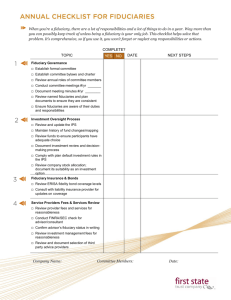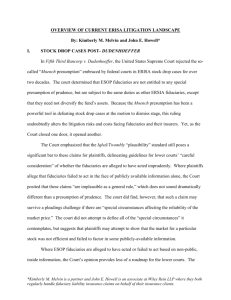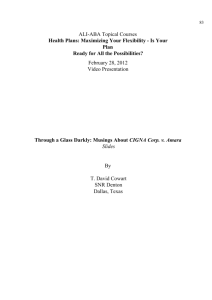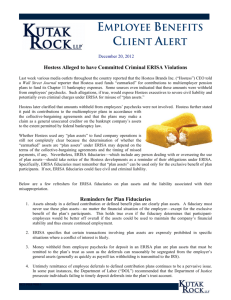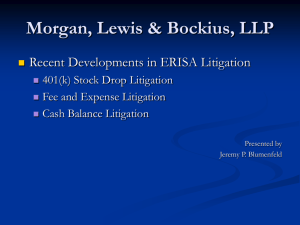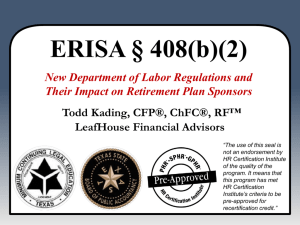mutual fund shareholders
advertisement
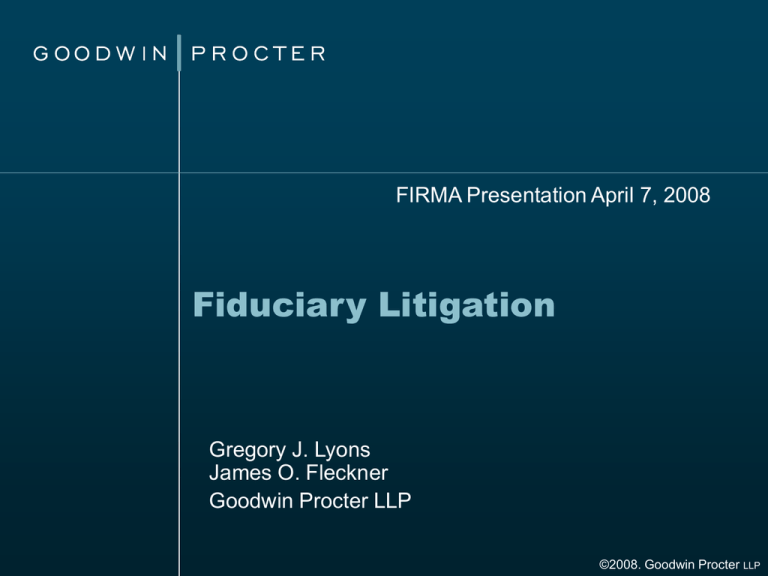
FIRMA Presentation April 7, 2008 Fiduciary Litigation Gregory J. Lyons James O. Fleckner Goodwin Procter LLP ©2008. Goodwin Procter LLP Fiduciary Litigation - Agenda • Why? • Securities – based litigation Plaintiff’s benefits and dilemma Cases based on fees/fiduciary duty (ICA §36(b)) Cases based on disclosure (34 Act §10(b)) • ERISA – based litigation Background Principal Cases • Stock drop cases • Excessive fee • Investment prudence 2 Why Institutional Fiduciary Litigation • Where the is Banks, fund firms, securities firms involved • Plaintiffs’ attorneys appetites whetted by market timing/late trading cases (2003) • Looking for the “next big thing” Excessive fees Intermediary “skimming” Investment performance 3 Mutual Fund Advisor Litigation Plaintiff’s Benefits and Dilemma • Despite complexity of cases, lawyers generally do not need deep legal background or to themselves find a “smoking gun” • Generally follows SEC enforcement action SEC has broad authority (including IA 206) to rely upon SEC action often provides the basis of the complaint 4 Mutual Fund Advisor Litigation Plaintiff’s Benefit and Dilemma • However, courts and Congress have severely limited private rights of securities-based action in federal cases • Sandoval (S.Ct. 2001) Congressional intent is keystone as to whether federal private right of action exists for a federal statute Courts may not create private right as a policy matter • Eaton Vance (2d Cir. 2006) Applies Sandoval standard to conclude 34(b), 36(a) and 48(a) of ICA provide no private right of action §36(b) provides sole private right under ICA (excessive fee only) • Private right also available under §10(b) of Exchange Act But PSLRA (1995) provides high burden of proof 5 Mutual Fund Advisor Litigation Plaintiff’s Benefit and Dilemma • Also possible to pursue at state court level as a fiduciary action • However, some significant states limit such action New York – Martin Act • State law claims also not as easy for plaintiff’s attorneys to pursue less prevalent 6 Mutual Fund Advisor Litigation Fiduciary Duty • Based on ICA § 36(b) “The investment adviser of a registered investment company shall be deemed to have a fiduciary duty with respect to the receipt of compensation for services, or of payments of a material nature, paid by such registered investment company, or by the security holders thereof, to such investment adviser or any affiliated person of such investment adviser Plaintiff has burden of proof; courts consider approval process; no relief other than against fee recipient; relief limited to compensation received 7 Mutual Fund Advisor Litigation Section 36(b) Cases • Leading cases Gartenberg (2d Cir. 1982) • 6 factor test Amron (2d Cir. 2006) • Sets high pleading standard • Leading cases stop many actions at early stages • Often difficult for plaintiffs to “shoehorn” into 36(b) • Funds likely to fight because goes to business model 8 Mutual Fund Advisor Litigation Section 36(b) Cases • Gartenberg – Fee must be “so disproportionately large that it bears no reasonable relationship to services rendered and could not have been the product of arm’s length bargaining” • 6 factors Nature and quality of IA services Profitability of mutual fund to IA “Fall-out” benefits Economies of scale and whether passed on to shareholders Comparative fee structure with similar funds Independence/conscientiousness of fund outside directors • Amron – Plaintiffs must allege “facts pertinent to the relationship between fees and servicer” 9 Mutual Fund Advisor Litigation Section 36(b) Cases • Application of Gartenberg and Amron Principles in SSB (S.D.N.Y. 2007) (Services) – Allegations of underperformance insufficient – must show fees excessive relative to actual services provided. (Profitability) – Showing of profitability without allegation of corresponding cost not sufficient – industry wide data not enough (Fall-Out) – Propriety of directed brokerage, other fees etc. not relevant to 36(b); rather basically an economic test (Economies of Scale) – Size of funds not sufficient without showing of costs; non-fund specific data insufficient (Comparative Fees) – Expense ratio comparison raises little suspicion • Not necessary that funds received lowest possible fees, as long as within range (i.e., institutional investors not comparable) – Jones (N.D. Ill. 2007) 10 Mutual Fund Advisor Litigation Section 36(b) Cases • Importance of fund board process • Courts will review in-depth the data (comparable and otherwise) provided to trustees, issues they reviewed, and board composition issues (relationship to management) 11 Mutual Fund Advisor Litigation Fund Disclosure - Basis • Exchange Act § 10(b) prohibition: “To use or employ, in connection with the purchase or sale of any security registered on a national securities exchange or any security not so registered … any manipulative or deceptive device or contrivance in contravention of such rules and regulations as the Commission may prescribe as necessary or appropriate in the public interest or for the protection of investors” • Arises in disclosure of fees and their allocation, and recommendation of investments 12 Mutual Fund Advisor Litigation Fund Disclosure - Limitations • As with 36(b), significant limits on claims • With 10(b), to avoid dismissal PSLRA requires complaint to “state with particularity facts giving rise to strong inference that the defendant acted with the required state of mind” (scienter, i.e., intent to defraud) No discovery pending resolution of motion to dismiss raises stakes • Tellabs (S. Ct. 2007) – Court must also look at plausible opposing inferences; inference of intent to defraud must be cogent and compelling as opposing inference 13 Mutual Fund Advisor Litigation §10(b) – High Bar for Plaintiffs • In re: Smith Barney Fund Transfer Agent Litigation (S.D.N.Y. 2007) • Plaintiffs allege 10b-5 violation because defendants did not disclosure allocation of fees amongst affiliates • Court grants defendant motion to dismiss because when total fees are disclosed “other information about the fees, such as their allocation … is not material” 10b-5 violation only if plaintiffs allege with particularity that undisclosed profits resulted in “tainted investment advice” 14 Mutual Fund Advisor Litigation §10(b) – Another Avenue - Advisor Stock Price • Janus Capital Group (D. Md. 2007) • Suit against asset manager of mutual fund for drop in advisor’s stock by virtue of market timing issue Plaintiffs relied on misstatements in fund prospectuses • No aiding and abetting liability under Section 10(b) Central Bank (S. Ct. 1994) • Court dismissed because alleged fraud directed at mutual fund shareholders, not corporate parent • Stoneridge (S. Ct. 2008) further limiting “scheme – liability” 15 Hedge Fund Advisor Litigation • 36(b) not available, thus 10(b) is principal claim Bayou Hedge Fund (S.D.N.Y. 2007) • Plaintiff claims violation because defendant (IA) improperly recommended hedge fund (via Powerpoint and otherwise) Allege violations regarding accountant, profitability, investment strategy and other matters • Court - self-imposed standards of defendant are not the proper framework to apply 16 Scope of ERISA • ERISA governs all U.S. employee benefit plans, except “government plans” and most “church plans” • ERISA governs the behavior of plan fiduciaries Fiduciaries are those who exercise discretionary authority or control on behalf of the plan (ERISA Section 3(21)(A)) Wide range of individuals and entities can be fiduciaries, depending on facts and circumstances: plan administrator, investment managers/advisors, consultants, trustees, insurers 17 ERISA Fiduciary Duties – Breach of These Duties is the Basis for Exposure to Litigation • General fiduciary duties (ERISA Section 404(a)) – exclusive benefit, prudent man, diversification, and compliance with plan documents • Prohibited Transactions Transactions with a “party in interest” (ERISA Section 406(a)) • Party in interest is very broadly defined Fiduciary self-dealing and conflicts of interest (ERISA Section 406(b)) There are numerous exemptions, each with its own specific conditions • Co-fiduciary Responsibilities (ERISA Section 405(a)) 18 ERISA Remedial Provisions • Claims relating to benefits (ERISA Section 502(a)(1)(B)) Can be brought by participants or beneficiaries • Fiduciary breach claims (ERISA Section 502(a)(2)) Can be brought by plan fiduciaries, participants or beneficiaries, or the Department of Labor (DOL) Can obtain money damages for plan (plan’s loss and/or fiduciary’s gain) or other equitable or remedial relief (ERISA Section 409) • Broad equitable relief to redress any violation of Title I of ERISA or the terms of the plan (ERISA Section 502(a)(3) or (a)(5)) Can be brought by plan fiduciaries, participants or beneficiaries, or DOL Can be brought against non-fiduciaries as well as fiduciaries • Civil penalty (ERISA Section 502(l)) Cases brought by (or settlements with) DOL 20% of “applicable recovery amount” 19 Recent Trends in Retirement Plans • In 2007, over $17 trillion was invested in U.S. retirement vehicles (ICI) • Increasingly, retirement assets are moving from defined benefit plans to defined contribution plans Between 2003 and 2007, investments in defined contribution plans rose from $3 trillion to $4.4 trillion (ICI) Wave of the future • Defined contribution plans also are offering more non-registered products Between 2003 and 2006, demand for collective investment trusts in defined contribution plans rose from 32% to 41% (AST Capital Trust white paper) Business and legal impetus 20 The Changing Face of ERISA Litigation • Historically, ERISA litigation had focused principally on claims for benefits or on one-off cases of egregious behavior by plan fiduciaries • The last eight years have seen burgeoning litigation charging breach of fiduciary duty, often brought against financial service companies Brought against named fiduciaries, independent fiduciaries, investment managers, plan trustees (including directed trustees), and plan service providers (e.g. record-keepers and consultants) Complex suits, generally class actions Large loss claims Frequently companion piece to securities fraud actions 21 Why The Litigation: Again More Perfect Storms • Confluence of factors • Ever prospecting plaintiffs’ bar: Why rob banks? That's where the money is • Focus on defined contribution plans • Market volatility and large market cap losses (2000-01 tech bubble; 2007-08 subprime and credit issues) • Advantages to plaintiffs of ERISA litigation over securities litigation Pleading standards: sufficient facts to support inference of breach of fiduciary duty vs. particularized facts supporting strong inference of fraudulent intent Standard of conduct: breach of fiduciary duty vs. fraud 22 Challenges to Industry Customs & Business Models • We will review today three waves of this recent type of ERISA litigation Stock drop litigation against plan fiduciaries and directed trustees: the role of the directed trustee Excessive fee litigation against plan fiduciaries and service providers: service and pricing bundling, revenue-sharing, selection of options on 401(k) lineups, and disclosure to plan fiduciaries and participants Investment prudence litigation against investment fiduciaries: subprime MBS, ABS, and beyond • We will also review expansion of ability to raise a claim in the DC context • This litigation challenges financial services industry customs and business models 23 The First Generation – Stock-Drop Cases • Triggered by tech bubble burst, 2000-01 • Participant class actions against named fiduciaries and trustees, both independent and directed • Claim: imprudent selection and maintenance of sponsor stock fund on 401(k) lineup; often accompanying disclosure claims • Companion piece to securities fraud claims • Over 100 ERISA suits • Huge losses • Poster child collapses: Enron, WorldCom 24 Bad Facts Make Bad Law – Enron and Directed Trustees • Customarily directed trustees followed named fiduciary directions to invest in sponsor stock fund if plan documents provided for a stock fund. No independent assessment of prudence • Enron: Egregious facts and Department of Labor amicus brief opposed trustee's motion to dismiss by pointing to “red flags” • Consternation and confusion in directed trustee segment of financial services industry Contracts do not provide for fiduciary oversight Trustees not compensated for work or risk of prudence review Metaphors do not provide practical guidance • Litigation with unsettling results: Named fiduciaries often lose motions to dismiss; many settle Directed trustees also lose motions to dismiss Some directed trustees win motions to dismiss: Textron, Cardinal Health, USAir Merrill Lynch achieves summary judgment in WorldCom 25 Directed Trustees – The December 2004 Field Assistance Bulletin • Extensive industry lobbying and negotiation with Department of Labor • The FAB: the premises Directed trustee duties are limited; not first line fiduciary Duties premised on assumption of efficient securities markets and regulatory obligations of plan sponsors under securities laws • Duties Trigger of duty is trustee's possession of information: • Public information: “clear and compelling public indicators, as evidenced by an 8-K filing [with SEC], a bankruptcy filing, or similar public indicator that calls into serious question a company's viability as a going concern.” • Non-public information: “material non-public information that is necessary for a prudent decision.” For example, “information indicating that a company's public financial statements contain material misrepresentations” such that the trustee “could not simply follow a direction to purchase that company's stock at an artificially inflated price.” Duty is to inquire of named fiduciary • FAB given recognition in WorldCom, USAir, Cardinal Health • Litigation against directed trustees all but ceases 26 Directed Trustees – Clouds on the Horizon • The recurring risk of stock drops with market cycles: e.g., companies with stock price affected by subprime, MBS or ABS business or investments • Department of Labor consideration of restating the duties of directed trustees through enforcement action Different triggers of duty Different duty 27 Characteristics of ERISA Revenue Sharing Cases • These suits generally contain allegations that the defendants breached fiduciary duties by either: Failing to investigate or disclose “revenue sharing” payments received by 401(k) plan providers through 12b-1, sub-transfer agency or other arrangement, including claims as against bundled service providers; or Causing or allowing 401(k) plans and their participants to be charged excessive fees for services through selection of investment options and/or payments to record-keepers • Challenges to use of retail mutual fund options on investment menu • Challenges to use of actively managed product on investment menu 28 Characteristics of ERISA Revenue Sharing Cases • Claims have been brought against plan sponsors, inside fiduciaries, and service providers such as trustees, record-keepers, investment managers, and consultants • Over 20 such suits have already been filed and more are likely to follow … • Suits generally break down into two types, each of which are brought as class actions: Suits by participants and beneficiaries of large plans (>$1B) against sponsor, named fiduciaries, and occasionally service providers Suits by sponsors and named fiduciaries against trustee, record-keeper, and in one instance, plan consultant 29 Early Victories for Defendants • Hecker v. Deere & Co. 496 F. 2d 967 (W.D. Wis. 2007) Four participants alleged that sponsor and service provider offered investment options that had “excessive and unreasonable fees and costs” Service provider dismissed for lack of relevant fiduciary status where sponsor “has sole responsibility for selection of plan investment options” Case currently on appeal. DOL submitted amicus brief on March 19, 2008 in support of reversal. As to directed trustee and investment advisor, DOL argues: • Complaint properly pleads functional fiduciary status based on management of plan funds and role in selection of options • Fiduciary status not arise by virtue of “developing and presenting a list of investment options” for named fiduciary consideration • “Revenue sharing” funds from advisor to trustee are not “plan assets” • Young and Brewer v. GMIMCo Nos. 07-1994, 07-2928 (S.D.N.Y.) Case brought by participants of eight GM related plans against named fiduciary and trustee for claims, among others, of allowing plans to be invested in funds with allegedly “excessive fees” Court dismissed all claims on March 24, 2008, holding that claims are barred by three year statute of limitation where information on funds’ expense ratios were “readily apparent” 30 Early Victories for Plaintiffs • Haddock v. Nationwide Financial Services 419 F. Supp. 2d 156 (D.Conn. 2006) Trustees of five separate defined contribution plans sued Nationwide for ERISA violations based on allegations of excessive mutual fund revenue sharing payments In March 2006, a federal district court denied Nationwide’s motion for summary judgment holding that material facts existed as to whether (1) Nationwide’s status as the plan’s investment provider made it a “fiduciary” and (2) the funds used for revenue sharing payments constituted “assets of the plan” • Tussey v. ABB, 42 Employee Benefits Cases 2863 (W.D. Mo. Feb. 11, 2008) Participants and beneficiaries of two 401(k) plans sued sponsor, named fiduciary committees, individual, trustee/record-keeper and investment advisor for breach of ERISA fiduciary duty arising from alleged excessive fees Court denied all defendants’ motions to dismiss, holding, among other things, that (1) it could not decide at the pleading stage whether per-participant fees were “significantly in excess of rates charged by other plans” and (2) whether trustee and investment advisor were relevant ERISA fiduciaries 31 Suits and Regulatory Investigations Involving Subprime Mortgage Investments • ERISA claims have recently emerged in connection with the tightening of the mortgage credit market • Many suits are in the nature of a stock drop, alleging that the bank, mortgage lender, or other financial service provider sponsoring a plan breached ERISA fiduciary duties by continuing to allow plans to invest in employer stock • Other suits, not seen in burst of tech bubble, target investment managers for losses suffered by plans due to investments in mortgage-backed securities 32 Suits and Regulatory Investigations Involving Subprime Mortgage Investments • One investment manager is currently facing at least four separate ERISA suits over its management of bond funds impacted by the tightening credit market sparked by troubles in the subprime mortgage industry Claims for misrepresentation and mismanagement Claimed losses of hundreds of millions, if not billions, of dollars • Department of Labor investigations triggered – Defined Contribution & Savings Plan Alert, November 19, 2007 33 Defined Contribution Plan Investments in a Sponsor’s Own Product • Class action suits brought in October and November 2007 against financial services companies offering their, or their affiliate’s, investment products to plans they sponsor Claims of breach of fiduciary duty and prohibited transactions, brought without regard to compliance with PTE 77-3 and ERISA §408(b)(8) • Mehling v. N.Y. Life, 2008 WL 597725 (E.D. Pa.) Participants of N.Y. Life sponsored DB and DC plans brought suit challenging investment of plan assets into N.Y. Life sponsored investment products, including mutual funds Court approved settlement on March 4, 2008. Under settlement, N.Y. Life and/or its insurer to pay $14,000,000, and N.Y. Life agrees to an independent advisor for the plans through May, 2010 34 Easing Defined Contribution Participant Claims: LaRue v. DeWolff, Boberg & Associations, Inc., 128 S.Ct. 1020 (February 20, 2008) • Supreme Court holds that participants in DC plans may sue ERISA fiduciaries for losses to individual plan accounts under ERISA §502(a)(2) Plan participant alleged that administrator failed to carry out participant investment instruction; claimed loss of approximately $150,000 Overturned 4th Circuit decision that ERISA only permits claims for losses to entire plan Refinement of Russell v. Massachusetts Mut. Life Ins. Co., 473 U.S. 134 (1985) 35 Easing Defined Contribution Participant Claims • LaRue majority decision (Stevens. J.) based on changing benefit plan “landscape” Movement from DB DC Plans • Concurring opinions support result, but rely on different analyses Justice Thomas concurred in judgment, joined by Justice Scalia • Employed a strict textualist approach to ERISA • Losses to a DC plan are necessarily the aggregate of losses to balances of individual plan accounts and thus can be redressed under ERISA §409(a), made applicable by ERISA §502(a)(2) Justice Roberts concurred in part and concurred in judgment, joined by Justice Kennedy • LaRue’s claim might be construed as one for benefits, and, if so, should have been brought under ERISA §502(a)(1)(B); such claims include safeguards for fiduciary, such as exhaustion of administrative remedies 36 General Rules For Limiting Exposure Three Basic Rules: • Know your role Fiduciary/nonfiduciary Extent of fiduciary functions • Pay close attention to the documents Governing agreements Disclosures and other communications • Establish and follow effective procedures Prudence is largely a matter of process Compliance with prohibited transaction exemption conditions 37 Gregory Lyons – (617) 570-1329 glyons@goodwinprocter.com James Fleckner – (617) 570-1153 jfleckner@goodwinprocter.com ©2008. Goodwin Procter LLP

